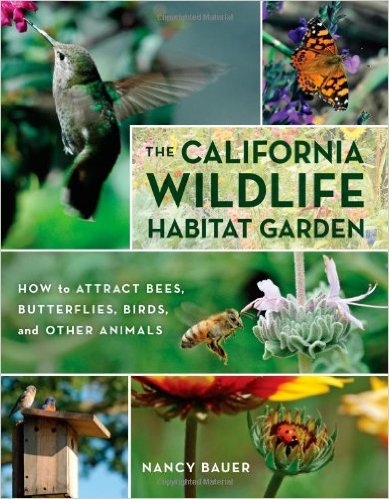The California Wildlife Habitat Garden: How to Attract Bees, Butterflies, Birds, and Other Animals by Nancy Bauer. University of California Press, published in 2012, 232 pp.

This book is laid out in 5 chapters. First is a discussion of what constitutes a wildlife garden, with a garden profile of a Walnut Creek garden that illustrates the main principles (providing food, shelter, and water). The following 4 chapters each focus on different types of habitat gardens, including bird habitats, pollinator gardens, wildlife ponds, and front yard habitats, each with garden profiles and discussions of challenges and solutions the homeowners developed for their particular properties. Appendices include guidelines for wildlife gardens, native plant communities, uses of hedgerows, common California butterflies and host plants, and invasive pest plants, among other topics.
The book has several features that I really valued. First, there are lots of photographs. While I like the photographs as eye candy, I also like to see how different plants are layered to create a more complex habitat. That's probably my own biggest challenge as a new habitat gardener - figuring out how to create layers of different heights of plants to give visual depth and provide lots of places for birds and small animals to shelter. Second, I like that the properties featured are different sizes, from several acres to less than 1/4 acre. Not all habitat gardens have to be vast expanses of expensive property. There is real value in creating small but rich habitats that create connectivity across larger landscapes. Third, I like that each chapter focuses on a different type of habitat garden. Whether a reader's particular interest is butterflies or birds or even dragonflies, there's a discussion that will be helpful in creating or enhancing habitat. Finally, many of the featured gardens have been created over time. I'm as much a victim of instant gardening gratification as the next person, but it's comforting to see that a wonderful habitat can develop even one plant at a time, since sometimes one plant is all I can afford.
One subject did give me pause, probably because I tend to be a habitat purist. This book talks about the use of non-invasive non-native plants in the habitat garden. But being a purist is not always realistic or helpful. Blooming ornamentals can be a supplement to native plants to provide nectar and pollen for honeybees, other pollinators and beneficial insects. Seeds of composites such as sunflowers, zinnias, and coreopsis can provide food in the fall for juncos, finches, and other seed-eating birds. Flowers of many medicinal and culinary herbs are excellent nectar sources for all types of pollinators. And the more I thought about the use of non-native plants to supplement and extend the value of a native habitat garden, the more I could feel myself softening. I still believe that a garden composed of mostly native plants will provide the most beneficial habitat for wildlife, but this book convinced me that there can be value in carefully chosen ornamental plants as well. And that, dear readers, was a very valuable lesson about keeping an open mind, one that I hope I'll remember in the future.